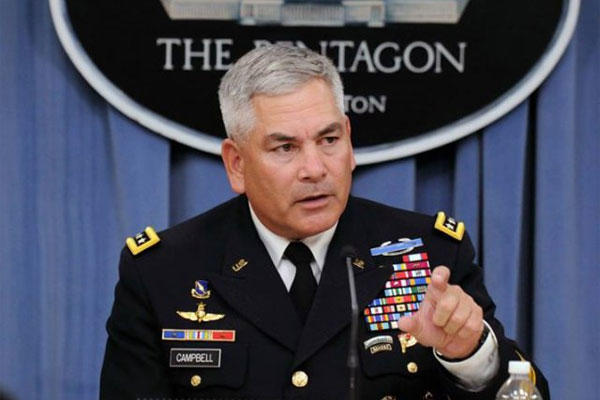The U.S. commander in Afghanistan told Congress Wednesday that the Afghan army and police continued to improve and overmatch the Taliban despite rising casualty and desertion rates.
"Army and police recruiting has not been a problem," Army Gen. John Campbell said, and "they will not let happen in Afghanistan what happened in Iraq."
In testimony to the House Armed Services Committee, Campbell didn't disagree with estimates that the Afghan army and police lost a total of about 20,000 troops and police last year to combat deaths and desertions, but said "it hasn't had a severe impact on their readiness."
Based on the Afghan's performance in the field in his six months in command, the general said, "I do not believe the Taliban-led insurgency represents an existential threat to the government of Afghanistan."
However, in his prepared statement for the Committee, Campbell said that "a high ANDSF (Afghan National Defense Security Forces) attrition rate, which accounts for casualties and all other losses to the force, has had an impact on combat readiness."
The general said Afghan casualties rose 5-7 percent last year compared to 2013 but he added that the Afghan army and police also conducted four times as many operations in 2014.
Campbell testified a day after reports surfaced that John Sopko, the special inspector general for Afghan Reconstruction (SIGAR), was releasing a report to Congress stating that the Afghan army "continues to suffer serious combat losses."
Between October 2013 and September 2014, more than 1,300 Afghan army troops were killed in action and 6,200 were wounded, the report said.
"Attrition continues to be a major challenge for the ANSF," the report. "Between September 2013 and September 2014, more than 40,000 personnel were dropped from ANA (Afghan National Army) rolls."
White not directly disputing SIGAR's statistics, Campbell said the report was based on information from a variety of sources, and some of the information was raw. He acknowledged that "we have to do a much better job at my headquarters" on providing data.
Last November, Campbell's own No. 2 in command reported fatalities in the Afghan forces that exceeded SIGAR's numbers.
Army Lt. Gen. Joseph Anderson, then-commander of the International Security Assistance Force Joint Command, said that Afghan forces had suffered nearly 9,000 fatalities since the beginning of 2013. He said that 4,350 were killed in 2013 and 4,634 in 2014.
Anderson said the casualty rate was "not sustainable," and he also told the New York Times that he was leaving Afghanistan in doubt on the nation's future.
Several Committee members told Campbell that Afghanistan's future would be largely dependent on the rate of the U.S. troop withdrawal, and they pressed Campbell on whether he was recommending changes.
Campbell said he wanted "flexibility" on the drawdown of U.S. troops within the confines of the existing plan to end the mission in early 2017, with the exception of embassy security and other small contingents.
Campbell said he has provided his chain of command with several options on the drawdown, but the options "do not go past '16 (2016). They were all providing flexibility within '15 and '16."
Under President Obama's current plan, the 10,600 U.S. troops now in Afghanistan would go down to about 5,500 at the end of this year, and all would be withdrawn towards the end of 2016.
-- Richard Sisk can be reached at richard.sisk@military.com
























